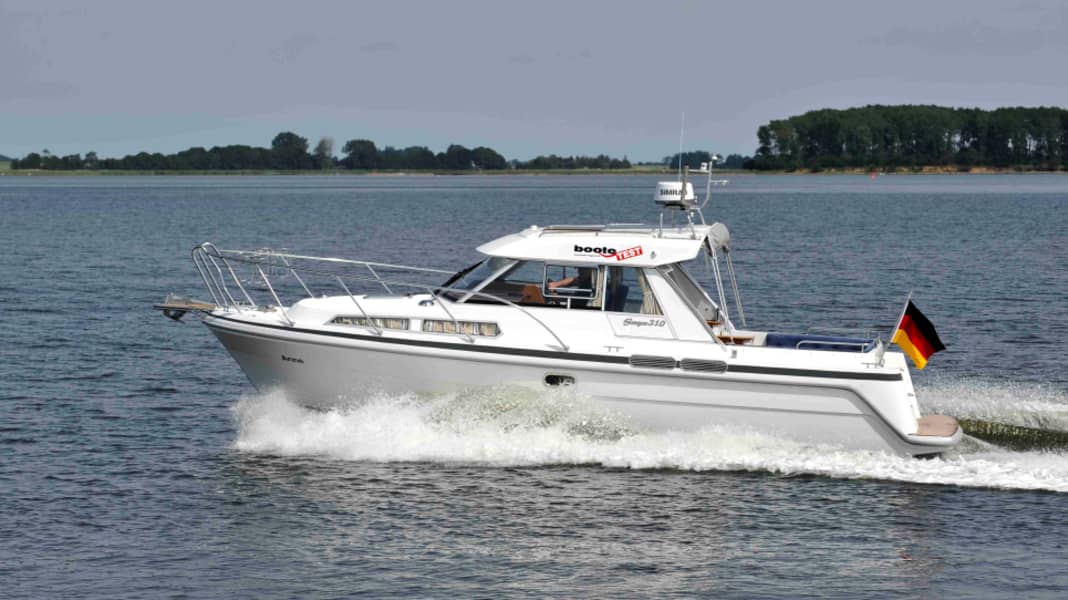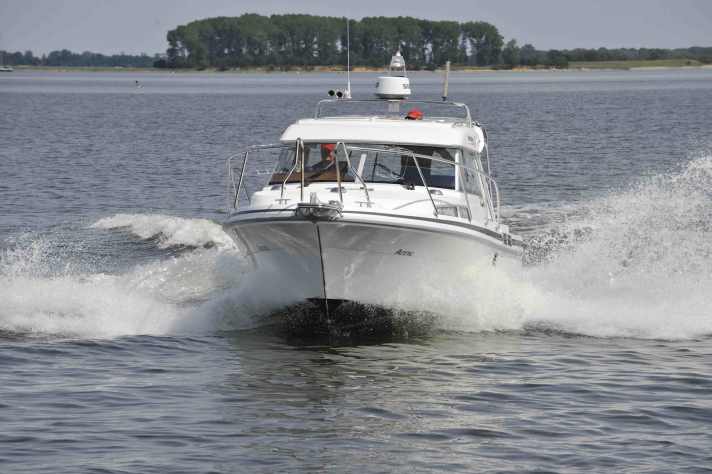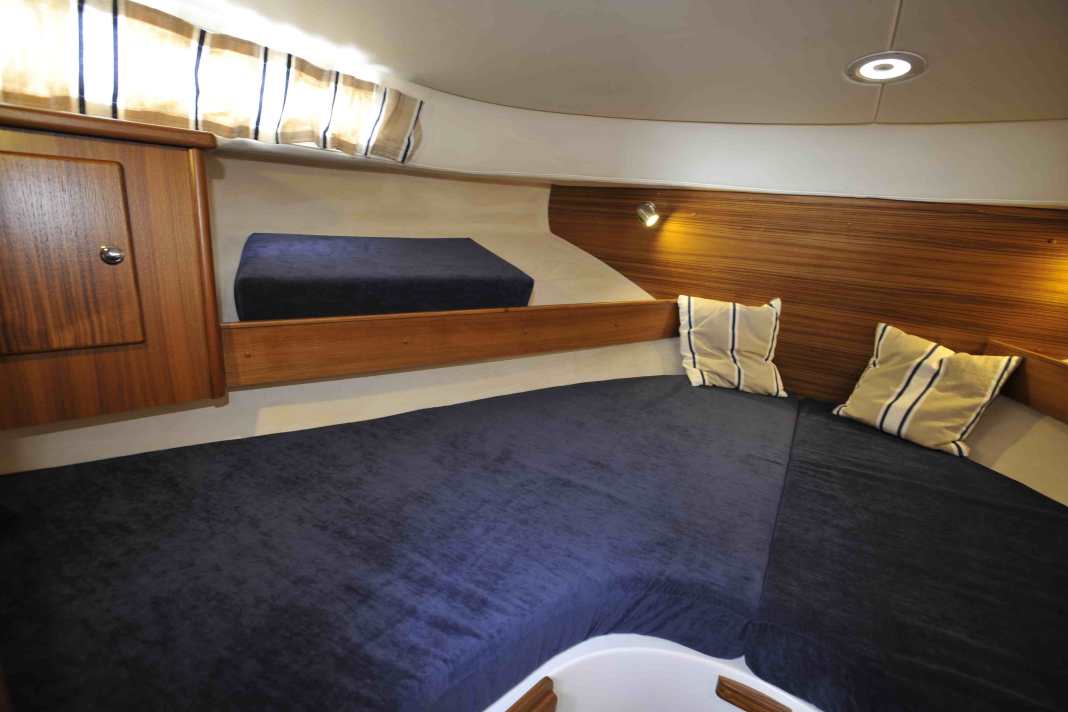

If you ask BOOTE readers about their "dream boats", the classic steel displacement boats are at the top of the list. Their Scandinavian counterparts made of plastic also rank high on the popularity scale. The disadvantage of these boats: on fast-flowing rivers, against the tidal current or in difficult seas, they can only be utilised up to around the theoretical hull speed, which sometimes requires a lot of patience.






The desire for higher speeds made the Scandinavian boat builders reach into their bag of tricks - they converted their boats into semi-planes. The stern is made flat and wide to give the hull a certain dynamic lift, and powerful diesel engines provide the necessary power.

Our test boat, the Saga 310, fits into this category and is well suited for a family of four with its 4 berths. And where can the journey take you? Inland and in coastal waters (CE category C). A categorisation that puts Saga on the safe side.
Driving and manoeuvring
In terms of motorisation, the shipyard takes a typically northern European approach and only offers single diesel engines. We travelled with the smallest engine, a D4-225 (160 kW) from Volvo Penta. The displacement speed is between just under 4 kn (idle speed) and the theoretical hull speed of almost 7 kn. The test boat runs stubbornly straight ahead over the entire cruising range, and even weight shifts by one person do not change this. The bow rises from around 1800 rpm and lowers again slightly around 3000 rpm. Despite raising the nose of the Saga, the foresight always remains sufficient.
The tail wave is powerful, peaking at 2200 rpm and becoming more "humane" again beyond that. To make the transition faster, the QL trim tabs are used to compensate for lean angles, for example from the wind.
Unusual: Semi-gliders generally do not have the typical gliding dip at high speed (lowest fuel consumption at high speed), at which the cruising speed sets in. The test saga, on the other hand, shows such a "sprit low", here you can recognise the most economical speed at 2800 rpm (a good 14 knots). One tank of fuel minus 15% reserve is then sufficient for 180 nm, which is a suitable value for this boat category.
The touring skipper is travelling at a good 500 nm, taking it slow at 6.5 knots. If you want to be part of the "fast troop", you have to accept a consumption of 2.31 l/sm at full throttle (3400/min/18.6 kn) and a maximum range of 155 nm.
If you turn a tight bend at full throttle, the hull briefly rests on the outside of the bend, straightens itself up again and then turns its laps flat as an iron. The carpool is able to maintain the lateral forces well. Due to the long ratio of the hydraulic steering (you have to turn the steering wheel a lot for a small rudder deflection), slaloming is hardly possible. The same is true when the steering is turned. On the test day, the Greifswalder Bodden showed its calm side, and we had to make do with pleasure craft and commercial vessel waves for the rough water test. The hull travelled through these absolutely smoothly and dryly.
Back in the harbour, our test boat can be moored safely and accurately with a rudder and specially installed bow thruster. Without a thruster, more practice is required, especially when travelling in reverse, as it is not possible to steer round without first intercepting with "short ahead". The smooth-running and well-positioned steering wheel ("Fisherman", with thick wooden rim) and the single-lever control with bow handle are operated.
The trim switches are located in front of the gearstick and are just as easy to reach as the rocker switches with symbols and indicator lamps. Apart from minor reflections, the instruments show their values unhindered. The view through the uncoloured safety glass pane is good.
To avoid flying blind in windy and rainy weather, Saga installs solid wipers with a triple switch, washer system and defroster. The driver's comfort is ensured by a firmly upholstered seat with armrest. Passengers find their place on an equally well-padded double bench. Shortcoming: A grab handle is missing, there are only cut-outs in the side rails and the armrest to hold on to.
Engine, tank, electrics
The engine is compactly located in an insulated compartment under the cockpit floor at about the height of the hardtop. It is accessible via a non-lockable hatch in the floor and via hatches at the front and aft, some of which are fastened with screws. Access to some corners is not great, so the shipyard had to make compromises here. The technicians laid cables and hoses solidly and firmly throughout the boat.
The tank system also makes a professional impression with its permanently installed aluminium tank stopcock, securely fastened hose connections and filter cartridges (exemplary with water alarm). The same care is taken with the entire electrical system with easily accessible circuit breakers and main switches as well as securely stowed 90 Ah batteries. A shore connection costs extra and includes the automatic charging unit, RCD switch, automatic circuit breaker and three 230 V sockets.
Security
The standard equipment includes a fire extinguishing system, fire extinguisher, hand bilge pump, electric bilge pump, escape hatch, emergency tiller and long bathing ladder, which can be easily operated from the water. Non-slip floor structures, side decks around 0.20 metres wide, sturdy railings and plenty of handholds ensure safe movement. The hand straps on the convertible top are a particularly positive feature, ensuring a good grip even when the top is up. Not convincing: although the sound insulation has a fire-retardant aluminium coating, the foam underneath is flammable.
Living, cockpit and equipment
Together with the hardtop, the soft top transforms the cockpit from an "open pleasure" into a practical "living kitchen". A 3-burner hob, oven, fridge with freezer compartment, sink and neat storage options are good equipment for the galley area. You can eat or chat on a comfortable seating area with a wooden table. It can not only be converted into a sun lounger, but can also be used as an emergency bunk. Further berths can be found in a spacious forward cabin and underfloor cabin, whereby the latter is perfect as a children's cabin due to its layout, size and equipment.
At the front, two adults lie on a bunk with an inlay cushion. There is plenty of stowage space in the cabins. On the starboard side, the designer has fitted the wet room with two fans, a deep stainless steel washbasin, mirror, towel rail, shower (hot/cold) and electric (extra) pump toilet. The latter pumps into a faeces tank, the extraction of which was shown as an extra on our test boat.
This connection will be standard on future models. If you want to enjoy the convenience of heating, autopilot, bow sunpad, bowsprit and anchor windlass, you will have to pay extra. A self-draining anchor locker, approved navigation lights (LED), a solid rubbing strake and six sturdy cleats come as standard
Data sheet: Saga 310
Shipyard: Saga
Type designation: Saga 310
CE category: C - Coastal waters
Material of hull and deck: Plastic
Length: 9,43 m
Width: 3,25 m
Displacement: 4,80 t
Price: 188.679,00 €

